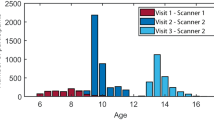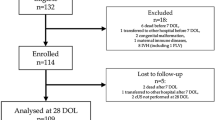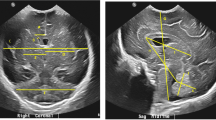Abstract
Background:
Reduced supratentorial brain growth has been shown in preterm-born infants at term-equivalent age (TEA), but cerebellar growth may be preserved in the absence of supratentorial injury. Our study aims to compare cerebellar size assessed using cerebral ultrasound (cUS) at TEA between preterm infants and term-born controls.
Methods:
Cerebellar dimensions (including transverse cerebellar diameter (TCD), cerebellar vermis height, anteroposterior vermis diameter (APVD), and cerebellar vermis area (CVA)) were measured using Image Arena software (TomTec Imaging Systems, Unterschleissheim, Germany) in 71 infants <32-wk gestation without significant scan abnormality at TEA and in 58 term-born control infants. Intra- and interobserver agreement were evaluated.
Results:
In comparison with controls, preterms at TEA had smaller TCDs (4.9 vs. 5.2 cm; P < 0.001) but larger CVAs (4.7 vs. 4.3 cm2; P < 0.005) and APVDs (2.4 vs. 2.2 cm; P < 0.001); however, these differences were no longer seen after accounting for head shape. In <28-wk gestational age infants, CVA was statistically similar to controls, as were for small-for-gestational-age infants.
Conclusion:
Our data support neonatal sparing of preterm cerebellar growth that is measureable using cUS, and this includes the most immature and small-for-gestational-age infants. We suggest cUS can be used to assess cerebellar size at TEA, with measures of both width and height being taken into account, and thus may be a useful tool for detecting infants with poorer cerebellar growth who are at increased risk of disability.
Similar content being viewed by others
Log in or create a free account to read this content
Gain free access to this article, as well as selected content from this journal and more on nature.com
or
References
Volpe J . The encephalopathy of prematurity—brain injury and impaired brain development inextricably intertwined. Semin Pediatr Neurol 2009;16(4):167–78.
Keunen K, Kersbergen KJ, Groenendaal F, Isgum I, de Vries LS, Benders MJ . Brain tissue volumes in preterm infants: prematurity, perinatal risk factors and neurodevelopmental outcome: a systematic review. J Matern Fetal Neonatal Med 2012;25:Suppl 1:89–100.
Haldipur P, Bharti U, Alberti C, et al. Preterm delivery disrupts the developmental program of the cerebellum. PLoS ONE 2011;6:e23449.
Schlapbach LJ, Adams M, Proietti E, et al.; Swiss Neonatal Network & Follow-up Group. Outcome at two years of age in a Swiss national cohort of extremely preterm infants born between 2000 and 2008. BMC Pediatr 2012;12:198.
Moore T, Hennessy EM, Myles J et al. Neurological and developmental outcome in extremely preterm children born in England in 1995 and 2006: the EPICure studies. BMJ 2012;345:e7961.
de Vries LS, van Haastert IC, Benders MJ, Groenendaal F . Myth: cerebral palsy cannot be predicted by neonatal brain imaging. Semin Fetal Neonatal Med 2011;16:279–87.
Boardman JP, Craven C, Valappil S, et al. A common neonatal image phenotype predicts adverse neurodevelopmental outcome in children born preterm. Neuroimage 2010;52:409–14.
Mathur AM, Neil JJ, Inder TE . Understanding brain injury and neurodevelopmental disabilities in the preterm infant: the evolving role of advanced magnetic resonance imaging. Semin Perinatol 2010;34:57–66.
Inder TE, Warfield SK, Wang H, Hüppi PS, Volpe JJ . Abnormal cerebral structure is present at term in premature infants. Pediatrics 2005;115:286–94.
Mewes AU, Hüppi PS, Als H, et al. Regional brain development in serial magnetic resonance imaging of low-risk preterm infants. Pediatrics 2006;118:23–33.
Graça AM, Cardoso K, Costa J, Cowan FM . Cerebral volume at term age: Comparison between preterm and term-born infants using cranial ultrasound. Early Hum Dev 2013;89 (9):643–8.
Horsch S, Muentjes C, Franz A, Roll C . Ultrasound diagnosis of brain atrophy is related to neurodevelopmental outcome in preterm infants. Acta Paediatr 2005;94:1815–21.
Lind A, Parkkola R, Lehtonen L, et al.; PIPARI Study Group. Associations between regional brain volumes at term-equivalent age and development at 2 years of age in preterm children. Pediatr Radiol 2011;41:953–61.
Srinivasan L, Allsop J, Counsell SJ, Boardman JP, Edwards AD, Rutherford M . Smaller cerebellar volumes in very preterm infants at term-equivalent age are associated with the presence of supratentorial lesions. AJNR Am J Neuroradiol 2006;27:573–9.
Shah DK, Anderson PJ, Carlin JB, et al. Reduction in cerebellar volumes in preterm infants: relationship to white matter injury and neurodevelopment at two years of age. Pediatr Res 2006;60:97–102.
Limperopoulos C, Soul JS, Gauvreau K, et al. Late gestation cerebellar growth is rapid and impeded by premature birth. Pediatrics 2005;115:688–95.
Limperopoulos C, Soul JS, Haidar H, et al. Impaired trophic interactions between the cerebellum and the cerebrum among preterm infants. Pediatrics 2005;116:844–50.
Limperopoulos C, Bassan H, Gauvreau K, et al. Does cerebellar injury in premature infants contribute to the high prevalence of long-term cognitive, learning, and behavioral disability in survivors? Pediatrics 2007;120:584–93.
Allin M, Matsumoto H, Santhouse AM, et al. Cognitive and motor function and the size of the cerebellum in adolescents born very pre-term. Brain 2001;124(Pt 1):60–6.
Parker J, Mitchell A, Kalpakidou A, et al. Cerebellar growth and behavioural & neuropsychological outcome in preterm adolescents. Brain 2008;131(Pt 5):1344–51.
Messerschmidt A, Prayer D, Brugger PC, et al. Preterm birth and disruptive cerebellar development: assessment of perinatal risk factors. Eur J Paediatr Neurol 2008;12:455–60.
Tam EW, Chau V, Ferriero DM, et al. Preterm cerebellar growth impairment after postnatal exposure to glucocorticoids. Sci Transl Med 2011;3:105ra105.
Graça AM, Cardoso K, Costa J, Cowan F . Assessment of gestational age using cerebellar measurements at cranial ultrasound: what is the best approach? Early Hum Dev 2013;89(1):1–5.
Van Kooij BJM, Benders MJNL, Anbeek P, Van Haastert IC, De Vries LS, Groenendaal F . Cerebellar volume and proton magnetic resonance spectroscopy at term, and neurodevelopment at 2 years of age in preterm infants. Dev Med Child Neurol. 2012;54(3):260–6.
Spittle AJ, Doyle LW, Anderson PJ, et al. Reduced cerebellar diameter in very preterm infants with abnormal general movements. Early Hum Dev 2010;86:1–5.
Fenton T . A new growth chart for preterm babies: Babson and Benda’s chart updated with recent data and a new format. BMC Pediatr 2003;10:1–10.
The International Neonatal Network. The CRIB (clinical risk index for babies) score: a tool for assessing initial neonatal risk and comparing performance of neonatal intensive care units. Lancet 1993;342(8865):193–8.
Makhoul IR, Goldstein I, Epelman M, Tamir A, Reece EA, Sujov P . Neonatal transverse cerebellar diameter in normal and growth-restricted infants. J Matern Fetal Med 2000;9:155–60.
Davies MW, Swaminathan M, Betheras FR . Measurement of the transverse cerebellar diameter in preterm neonates and its use in assessment of gestational age. Australas Radiol 2001;45:309–12.
Cuddihy SL, Anderson NG, Wells JE, Darlow BA . Cerebellar vermis diameter at cranial sonography for assessing gestational age in low-birth-weight infants. Pediatr Radiol 1999;29:589–94.
Zuccotti GV, Pogliani L, Dilillo D, Lista G, Radaelli G . Nomogram of the cerebellar vermis height at birth in small-for-gestational-age neonates. Acta Paediatr 2008;97:745–50.
Achiron R, Kivilevitch Z, Lipitz S, Gamzu R, Almog B, Zalel Y . Development of the human fetal pons: in utero ultrasonographic study. Ultrasound Obstet Gynecol 2004;24:506–10.
Brennan P, Silman A . Statistical methods for assessing observer variability in clinical measures. BMJ 1992;304:1491–4.
Acknowledgements
The authors thank Ana Isabel Lopes and Jorge Campos for reviewing the manuscript.
Author information
Authors and Affiliations
Corresponding author
PowerPoint slides
Rights and permissions
About this article
Cite this article
Graça, A., Geraldo, A., Cardoso, K. et al. Preterm cerebellum at term age: ultrasound measurements are not different from infants born at term. Pediatr Res 74, 698–704 (2013). https://doi.org/10.1038/pr.2013.154
Received:
Accepted:
Published:
Issue date:
DOI: https://doi.org/10.1038/pr.2013.154
This article is cited by
-
Confounding biases in studies on early- versus late-caffeine in preterm infants: a systematic review
Pediatric Research (2020)
-
Effect of Intraventricular Hemorrhage on Cerebellar Growth in Preterm Neonates
The Cerebellum (2017)



